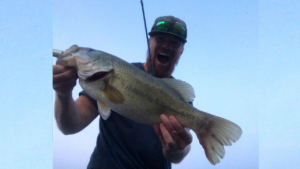
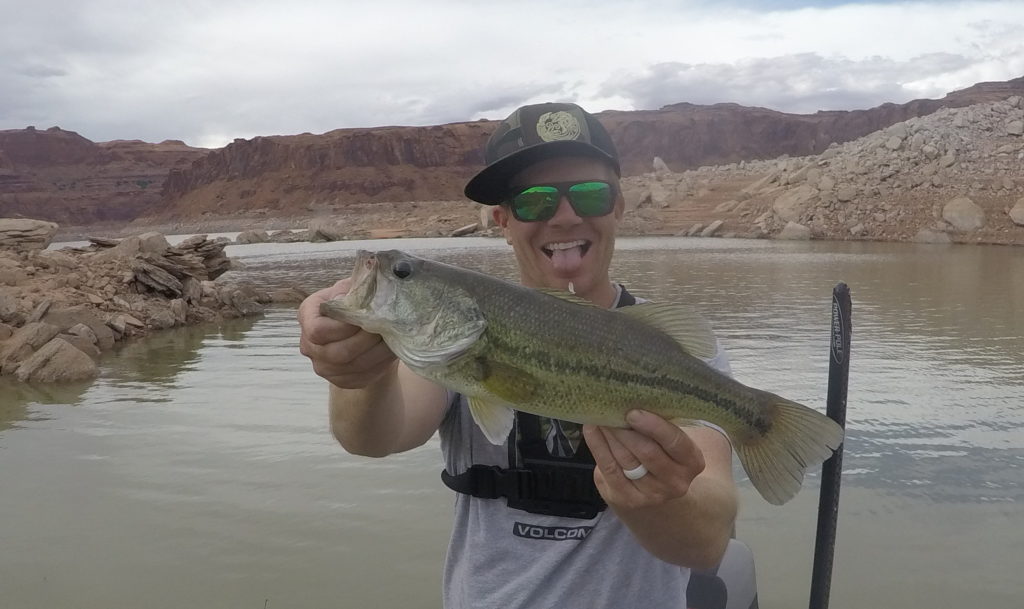
This article will help you know which jig fishing in clear water for bass will work best. The post outlines the basic fundamentals of selecting and picking a good jig for bass fishing in clear water. Including; what jig colors work best, how to modify your jigs to get more bites, and some video of these clear water jig fishing tips in action. After you are done reading this, you will be able to go out and catch more bass on jigs in clear water. Enjoy!
Here is the run down of how to know which jig fishing in clear water you should use. Jig fishing is a great way to catch bass. On the other hand, it can be totally fruitless if you don’t know what to do. I’ve spent hundreds of hours fishing jigs with little or no success until I finally put the puzzle together. Jig fishing is particularly different for clear water than stained and dirty water. Every pro says they always have a jig tied on, but if you don’t know what to do it can be very frustrating. Here’s all the things you need to put together a clear water jig to catch more bass. This will save you hours of wasted energy to avoid jig fishing mistakes others often make.
The jig is a perfect imitation of a crawfish molting which makes it an easy target for bass. The skirts on a jig flair, and move without you touching the line. This is why bass key in on a jig so often. If you pause and watch a jig underwater sitting on the bottom, the skirts continually move and flow. The main key elements of choosing the perfect jig is understanding color, head shape, weight, and size. Let’s dive into these items, so you can more fully understand what makes up a good clear water jig.
Color is important for choosing the right jig for clear water. The key is to have the most natural color possible. This means green, and brown hues are optimal for a jig. The best way to get the right color is find a crayfish in the lake, and try to imitate how it is colored. Overall, you can never go wrong with a solid green pumpkin color jig. I’ve found the green pumpkin color to work well universally throughout the clear mountain reservoir’s I fish.
The next important piece to a good jig is the head shape. Jig heads come in all kinds of shapes such as football, arkie, casting, structure, and flipping. There are lots of jig heads out to choose from. In clear water, I’ve found the best all around jig head is the arkie style head. This jig head works well for both casting, and pitching situations. It goes through cover pretty well, and it lays naturally on the bottom when working it back on a long deep cast. The eye comes off the jig at a 45 degree angle, and it just straight up works. Illustrated below is a picture of what an “Arkie” style jig head looks like.
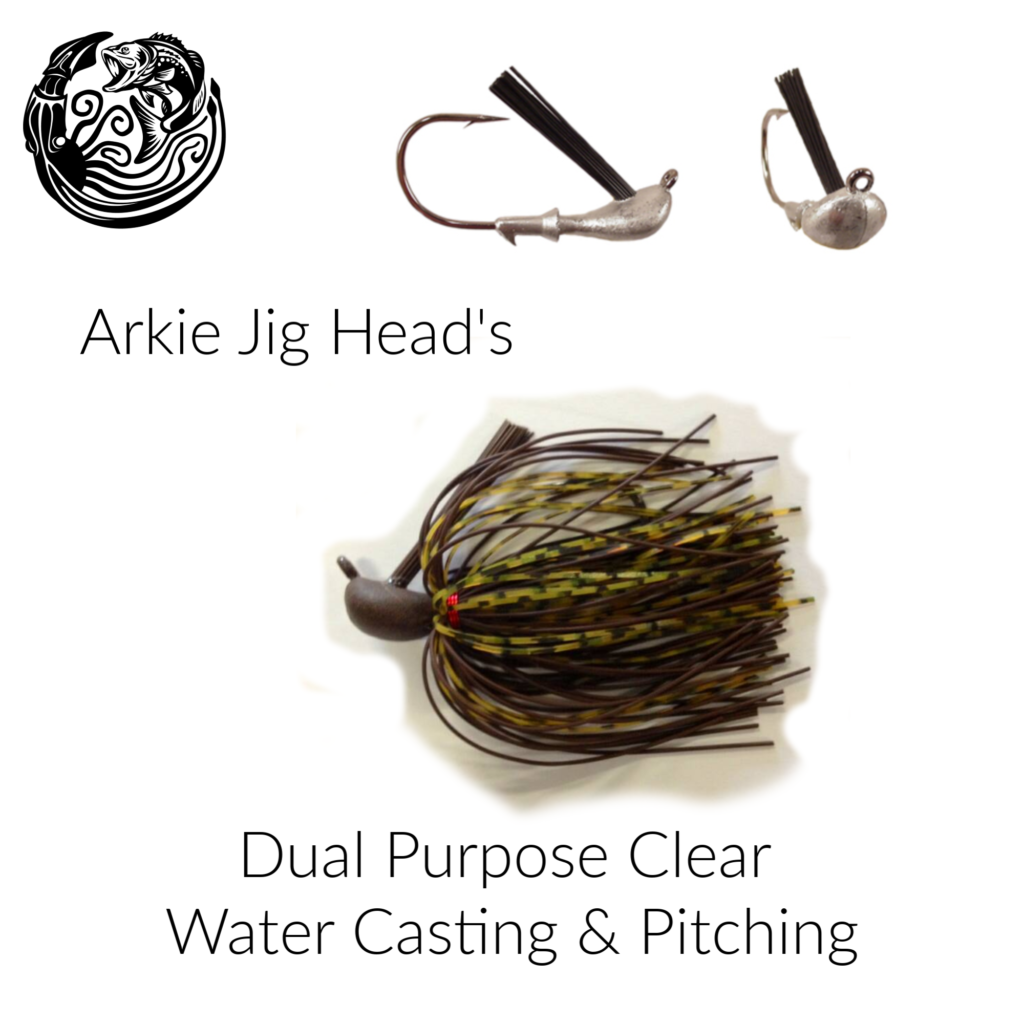
The weight of your jig plays a key roll in determining which jig fishing is best. If you watch a crawfish, they naturally sink slowly to the bottom unless they are swimming fast. In clear water it’s also important to not spook the fish with a big splash. For those two reasons a lighter jig head is often the best choice in clear water. 1/4 oz or less is a great light size to help you not spook the fish on entry, and also has a nice subtle fall. If you are going to fish deep, so you can get down to the fish quicker go with a 3/8 oz size or bigger.
The size or the length of the skirt on your jig plays a major part in whether a bass will bite. Most jig skirts are super long, so you can pair it how you want to the softplastic craw trailer you like. If the skirt is too long compared to your trailer, it will hide your trailer and restrict the action and natural look. A 3 inch softplastic craw on a 4 inch long skirt will not look normal in the water. You need to trim your skirts back to create a more realistic appearance to get more bites. The smaller your craw trailer, the more skirt you will need to trim off the back of your jig. A good rule of thumb is to always make sure the “claws” are able to be seen without the skirt interfering or covering them up.
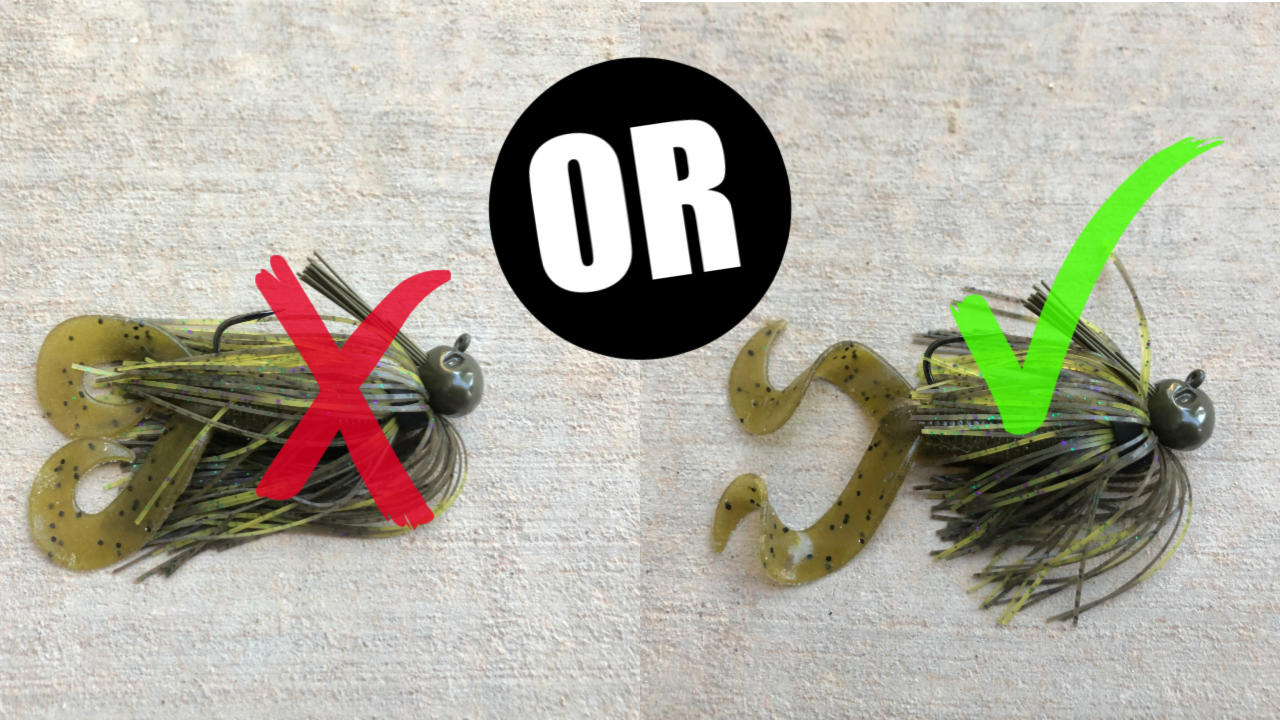
Here’s a list of some of my favorite jigs for clear water with links, so you can know which jig fishing to try.
Which jig fishing you use can be determined by the softplastic trailer you want. There are a variety of things to consider when picking a good softplastic trailer. Items such as color, size, shape, and the action of the softplastic all play a role. Jig fishing without a trailer is something I’ve done. It is surprising at how bites just don’t happen without a trailer. You absolutely need a trailer on your jig if you want to be more successful on the water jig fishing. Especially, in clear water conditions. Let’s dive into how color, size, shape, and action make or break your jig fishing trailer choices.
In clear water the straight green natural colors are best. Colors like watermelon, green pumpkin, and smoke are usually the best choices. One thing most people don’t realize is crayfish have a light under belly. This makes two tone color styles even more attractive to bass in clear water. Baits like the Bandito Bug, and the Pit Boss have colors with this two tone coloring. This coloring pattern will often draw bites because it looks more natural.
The size & shape of your softplastic trailer makes a difference on a jig. A wider fat softplastic craw will move more water to draw a bass’s attention. On the other spectrum a small slender craw will be more subtle. With a big softplastic trailer your jig will also fall slower. The opposite happens with a small trailer your jig will fall faster. The key is to find the best size trailer that matches the size of the crayfish in your lake. A 3 inch bait is usually the best choice. The smaller you pair down your softplastic trailers the more bites you get because it makes for an easier meal. Often, pro’s go with a bigger sized 4″ trailer, to only appeal to those bigger bass. A bigger craw trailer is a great way to try and get a bigger bass to bite.
Do you want a lot of kick in the tails, or no movement for your softplastic craw trailer? This is a good question. Typically, in colder water temperatures the less movement the better. Then as the water warms up a good kick in your tails on the fall or the swim is often a good choice. Maybe try something in between moving a little but not a ton. Sometimes the extra movement in the claws helps the bass feel where you bait is in the water. The most important thing with whatever craw trailer you choose, is to make sure you trim your skirts to allow those claws, flappers, and appendages to move freely.
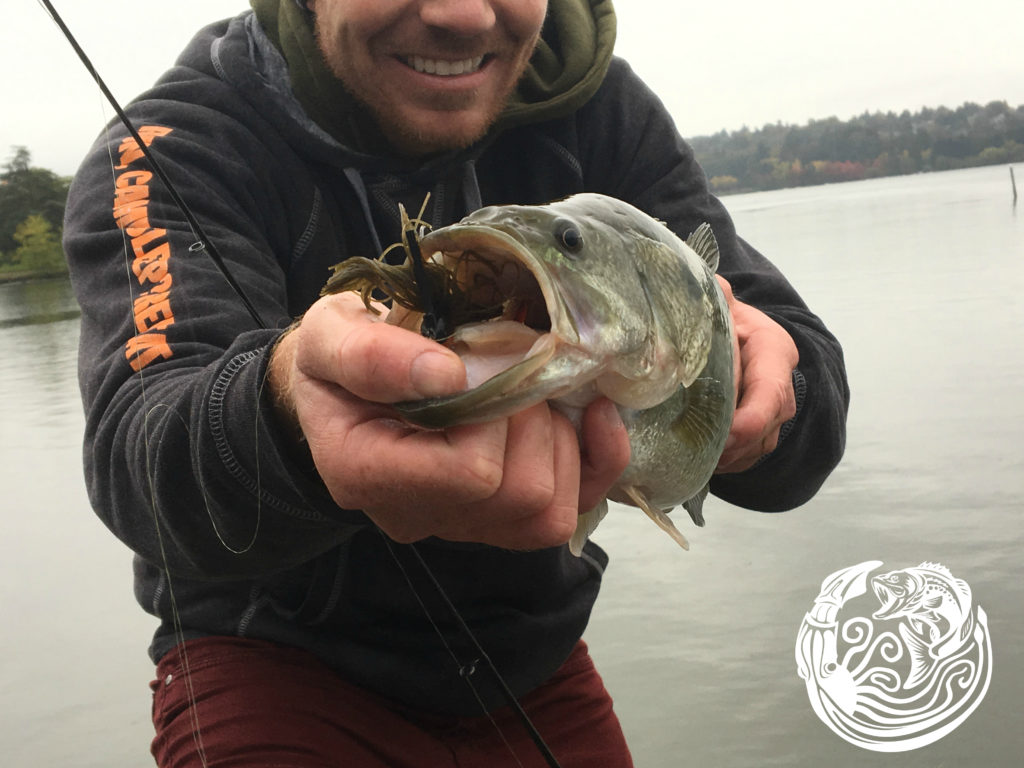
Here’s a bulleted list of some of the best softplastic craw jig trailers for clear water. The trailer you use should fit the jig you are throwing. The natural colors, and the right action and size can really make a big difference on whether a bass will eat your jig or not.
You need to modify your jig in order to hook up easier and get more bites. Here’s the step by step process to modifying your jig. Plus, a list the equipment you need to make modifying your jigs a faster process. This will help get your jig looking legit in clear water.
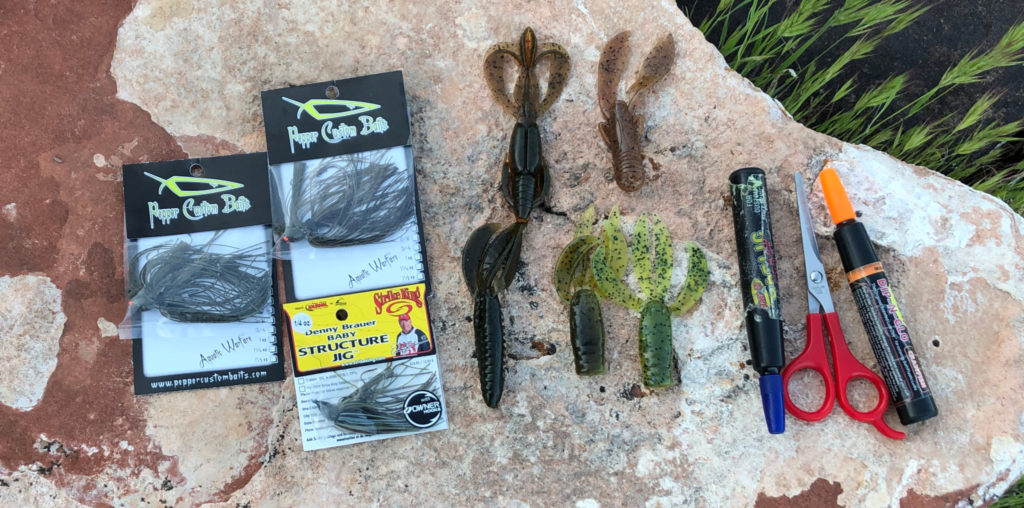
Here’s what I do to get my jigs rocking and rolling for bass fishing in clear water. Make sure you head to the video in this post to see these steps in action. Sometimes a visual walk through is helpful on seeing how to modify your jig properly.
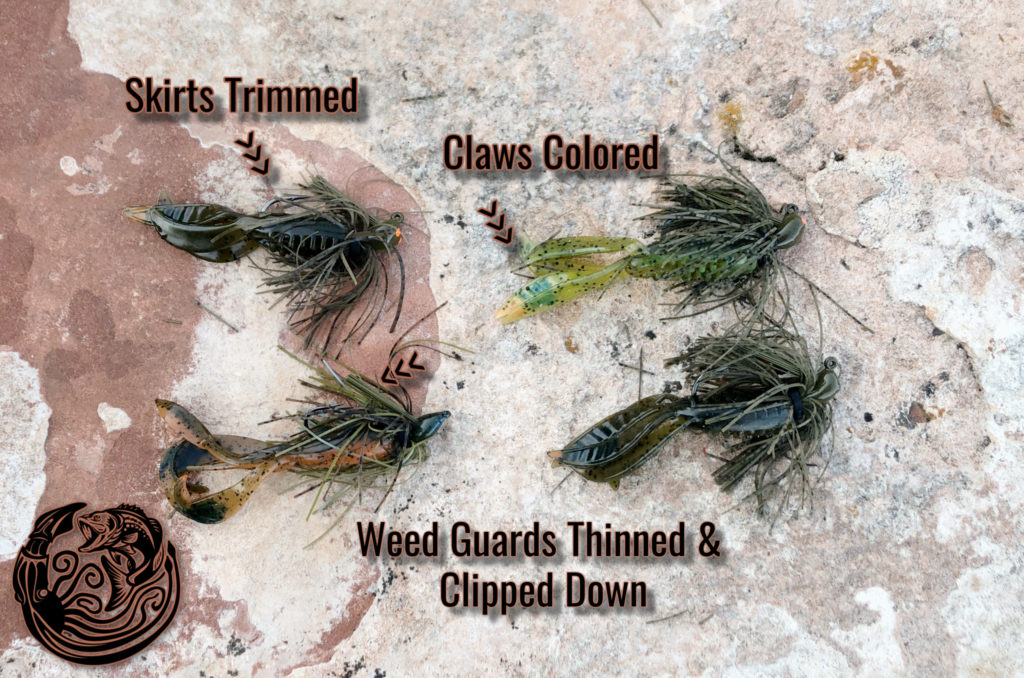
Alright, here is the moment you’ve been waiting for. The full video of jig fishing clear water. This will provide a better understanding of what yyou already read in this post, and you will also see a few fish catches to demonstrate why doing this will help you catch more fish. After this video and reading through this post, guaranteed you’ll be on your way to “Kraken” more bass on jigs this year in clear water.
One thing I’ve always found with jig fishing, is it’s not always the best option. It’s a great universal bait, but it does seem to perform best in lakes that have a high population of crayfish. Plus, it seems to work better when bass are holding close to the bottom. Although, In the summer you can sometimes rip a jig way up in the water column, and the bass will see it and follow it down to get it. You might want to consider a swim jig when fish are suspended more in thick cover. I like a jig when fishing around flooded cover, when the bass are on the bottom, and when you know you’ve got a high population of crayfish the bass will eat.
One more thing, The links above and below in this post are affiliate links were you can pick up baits, rod’s, reels, line, and anything else I use to “Krak” some bass fishing jigs. Krakenbass receives a small percentage of the sales through these links. I only use links to baits, and gear I personally trust and know work. These links are supposed to be helpful for you, and not for the small amount I make for the sale of the products. I hope these products can help you “krak” some bass like they have for me. Thank you for your support!
As Always,
Stay Stoked!
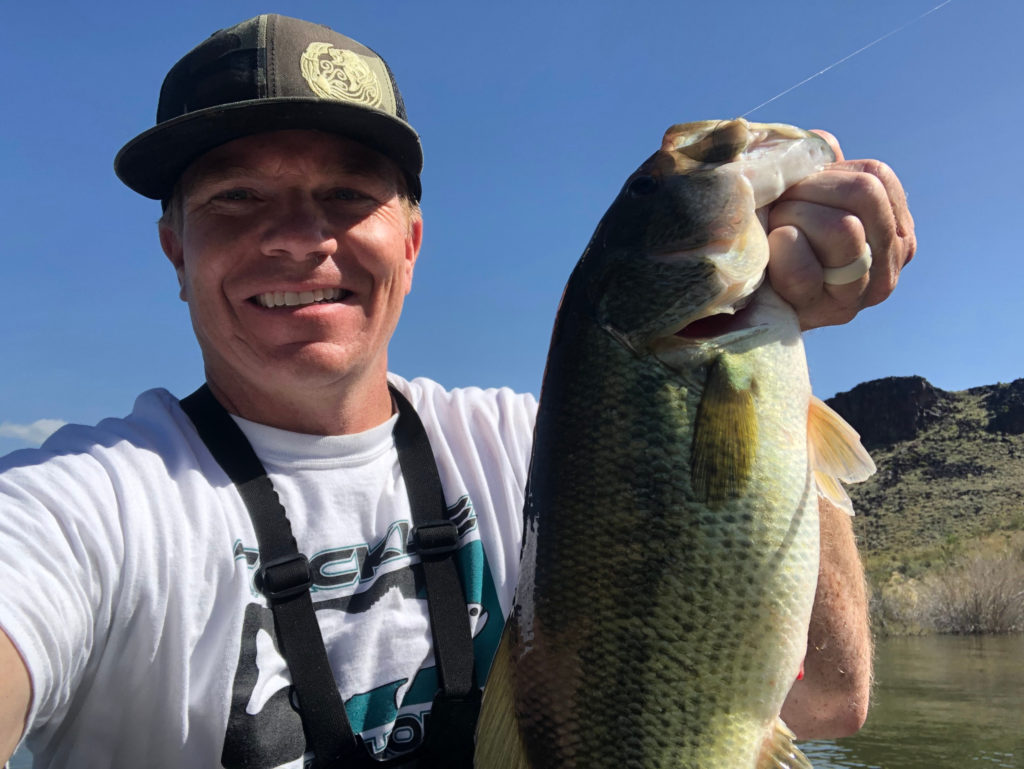
You need a system to know where to go, what to use and how to work your lures to catch more bass in every situation.
Use this lure color selection chart and perfectly match the color of your lure to what bass are wired to eat without trial and error so you can catch the monsters!
Discover how to perfectly match the color of your lure to what bass are wired to eat so you can catch the monsters!
2 Responses
Thanks for the incredible advice. I am changing my set up and tackle to get those bass. Keep up the good work always enjoy your videos.
Good artical, will be comming to LP this April to fish for bass. First time in a very long time. I will use your advive on baits. We will be comming in on the Bullftog side and fishing around there.